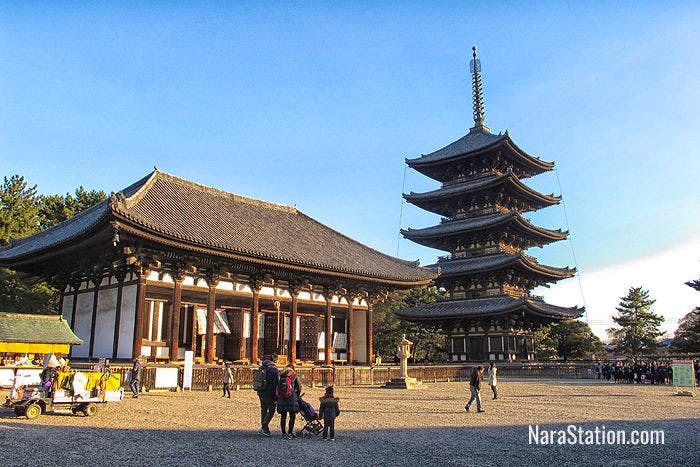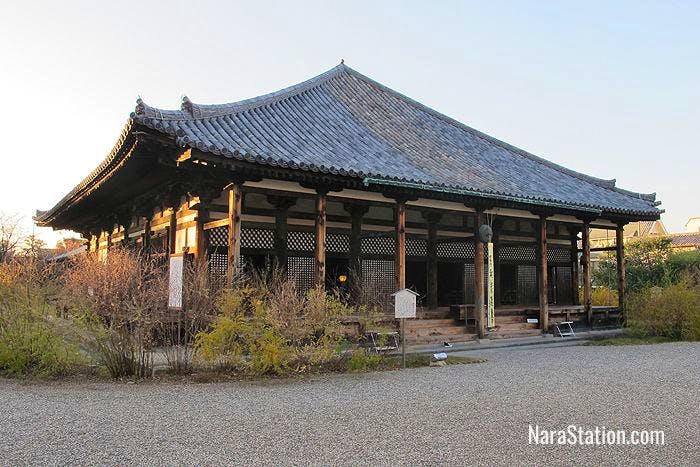Nara is an ancient city with many beautiful and historic attractions. The city was established as Japan’s capital city in the year 710 and remained so until 794 when the capital moved to Kyoto. This era is known as the Nara period in Japanese history and many of Nara’s famous shrines and temples date from this time.
Fortunately, because Nara is not a big city, the majority of Nara’s top attractions are located in a rather compact area around Nara Park. In fact all of these sights are within walking distance of the JR Nara and Kintetsu Nara stations. However, if you want to save some time you can also access most of these sights using the Nara Loop Bus. Below are our recommendations for ten locations that you must see when visiting Nara.
Table of Contents

The Eastern Golden Hall and Five Story Pagoda of Kofukuji
Kofukuji Temple
Kofukuji Temple was originally established in 669 in Yamashina, Kyoto. It was moved to its present location in 710 when Nara was made the nation’s capital. Over the centuries many buildings in the temple complex were lost to fires and wars, and the structures that remain today were mostly built between the 12th and 18th centuries. Among the buildings you can view here are the Three Story Pagoda which dates from 1181, the Five Story Pagoda which dates from 1426, and the Eastern Golden Hall or Tokondo which dates from 1415. These three buildings are all designated National Treasures.

The Nan-endo or Southern Octagonal Hall of Kofukuji is a designated Important Cultural Property
Reconstruction of the Central Golden Hall which was lost to fire in 1717 is currently ongoing and should be complete by 2018. Entrance to the temple grounds is free but entrance to the Kofukuji National Treasure Hall or Kokuhokan to view its collection of priceless Buddhist statuary and art costs 600 yen. Kofukuji is a designated UNESCO World Heritage Site. Map

Yoshikien Garden
Yoshikien Garden
This is a delightful spot in central Nara, which includes thatched tea houses, a pond garden, a moss garden and a flower garden. Formerly this was the site of a sub-temple of Kofukuji, but a private garden was laid out here in 1919. It is named after the little river Yoshiki which runs beside it. Yoshikien garden was opened to the public in 1989 and is now completely free for foreign visitors.
Admission: 250 yen but FREE for foreign visitors if you show your passport
Open: 9.00 – 17.00 (Last entry at 16.30)
Closed: February 15th – 28th
Map
Isuien Garden
Isuien, which is located right next door to Yoshikien, is another beautiful garden with pagodas, ponds, stepping stones, a water mill and thatched tea houses. There are actually two gardens here that were brought together in 1939 as a single continuous stroll garden. The smaller Western Garden was laid out by a rich leather tanner called Kiyosumi Michikiyo in the late 17th century.

A thatched tea house in the Western Garden
The larger Eastern Garden was laid out in 1899. Famously this garden employs the “borrowed landscape” technique to include Mount Kasuga and the roof of Todaiji Temple’s Nandaimon gate in its panoramic scenery.

The borrowed scenery of the Eastern Garden
The price of admission to the garden also includes entry to the Neiraku Museum which is located by the garden’s entrance. This art museum houses a collection of Chinese antiques, Korean ceramics, and Japanese tea utensils.
Admission:
Adults: 900 yen
High School Students: 500 yen
Elementary School Students: 300 yen
Open: 9.30 – 16.30 (Last entry at 16.00)
Closed: Tuesdays (except when Tuesday is a national holiday when it is closed on the following Wednesday instead), year-end and New Year holidays.
Map
Nara National Museum
Nara National Museum houses one of Japan’s foremost collections of Buddhist art. First established in 1889, the older Meiji era building was supplemented by a modern facility with two wings in 1973. The older building houses the Nara Buddhist Sculpture Hall which displays many superb examples of Japanese Buddhist statuary.
The West Wing of the new building displays paintings, calligraphy, and archaeological artifacts. The East Wing of the new building is mainly used for special exhibitions and also hosts the display of treasures from Todaiji Temple’s Shosoin treasure house every autumn. The two buildings are connected by an underground passageway which contains a museum shop, restaurant, and lounge. For more information please download a PDF guide to the museum.

The original Meiji era museum building was designed by Katayama Tokuma and dates from 1894
Admission:
Adults: 520 yen
College Students: 260 yen
High School & Younger: Free
Open: 9.30 – 17.00 (Last entry at 16.30)
Closed: Mondays (except when Monday is a national holiday when the museum is closed on the following Tuesday instead)
Map.
Nara Park
Nara Park is an expansive public park in central Nara which is famously the home of 1,200 shika deer which wander freely around the grounds. These deer were traditionally considered to be the messengers of the gods, but now have an officially protected status as living National Treasures.

The deer of Nara Park
The deer are technically wild, but quite unafraid of humans, so you can easily take pictures with them and you can buy rice crackers to feed them too. They can be quite persistent when fed however, so you might prefer not to give them food. Eating an ice cream in the park can also be problematic when a large number of deer try to share it with you! Many of Nara’s major attractions such as Kofukuji, Todaiji, Kasuga Taisha and the Nara National Museum are actually inside the park or on its edges and so this lovely green space is really the cultural heart of the city.
Open: 24 hours
Map

Remember never to run away from the deer of Nara Park or they will think you really have something tasty!
Kasuga Taisha Shrine
Kasuga Taisha Shrine was established in the year 768 by the powerful Fujiwara clan who held enormous influence at the imperial court. Traditionally the shrine was completely rebuilt every 20 years, but this custom came to an end in the 19th century.

The main sanctuary of Kasuga Taisha
The shrine is especially famous for its many lanterns. Stone lanterns line the paths that lead to the shrine, and there are many bronze lanterns inside. Kasuga Taisha and the ancient forest of Kasugayama which lies behind it are registered as a UNESCO World Heritage Site. Entry to the outer shrine is free but to enter the main sanctuary there is a fee of 500 yen.

The many lanterns of Kasuga Taisha
Opening Hours
April – September: 6.00 – 18.00
October – March: 6.30 – 17.00
Map
Todaiji Temple
Todaiji Temple is quite literally Nara’s biggest attraction. A temple was first established here in 728, but the Daibutsuden, or Great Buddha Hall, which houses a massive Buddha statue, was first built in 743. This building is currently believed to be the largest wooden structure in the world, but is actually two-thirds the size of the original building. Over the centuries it has been lost to fire twice and the current Daibutsuden dates from 1709.

The Daibutsuden
The Daibutsu or Great Buddha statue inside is 14.98 meters high and is the world’s largest statue of the Vairocana Buddha. Behind the statue is a wooden pillar with a hole in it that is said to be the same size as Buddha’s nostril. It is believed that if you can crawl through this hole, then you will achieve enlightenment. There is usually a line of children here waiting to crawl through it, but some adults try it too.

The Daibutsu statue sits in an attitude of enlightened meditation
Many of the buildings in the Todaiji Temple complex are free to view but to visit the Daibutsuden there is a fee of 500 yen for adults and 300 yen for children. This temple is a listed UNESCO World Heritage Site.
Opening hours for the Daibutsuden:
November – February: 8.00 – 16.30
March: 8.00 – 17.00
April – September: 7.30 – 17.30
October: 7.30 – 17.00
Map
Todaiji Nigatsudo

Nigatsudo
Nigatsudo is technically a part of the Todaiji Temple complex, but in reality is more of a sub-temple. It is located to the east of Todaiji’s Daibutsuden on the slopes of Mount Wakakusa. It is worth a visit simply to climb up to its balcony and take in the splendid view over Todaiji, Nara Park and Nara City beyond it.

The view from the balcony
This is also the site of the spectacular Omizutori fire festival which is held every year from March 1st – 14th. During the festival large flaming torches are carried by monks up on to the Nigatsudo balcony and waved over the crowd below. The sparks that shower down onto the onlookers are said to offer protection from bad luck during the coming year. Amazingly, this ritual has been performed here every year since 760.
Admission to the balcony: Free
Open: 24 hours
Map
Naramachi

Naramachi Shiryokan is a museum dedicated to this district’s history
Naramachi is the old merchant area of Nara where you can see many preserved traditional wooden townhouses. Typically these machiya townhouses feature white plastered walls with dark wooden latticework and tiled roofs. This is a great area to wander round and explore and you can find many restaurants, cafes, boutiques, souvenir shops, museums and galleries now housed in the old machiya buildings.

Nara Crafts Museum in Naramachi
Gangoji Temple
Gangoji Temple is located in the heart of the Naramachi district. This quiet and relatively simple temple may seem quite humble compared to bigger attractions in Nara like Todaiji and Kofukuji, but it because of its long history it is a designated UNESCO World Heritage Site. The temple was originally built in Asuka in 588 and was Japan’s first Buddhist temple. Originally named Asukadera, it was renamed Gangoji when it moved to the new capital of Nara in 718.

Gangoji Temple
Historically Gangoji was considered to be one of the powerful “Seven Great Temples of Nara,” but today it has more of the atmosphere of a local temple. Its peaceful buildings and grounds provide a pleasant break from the tourist crowds in other more popular areas.
Admission: 500 yen
Open: 9.00 – 17.00 (Last entry at 16.30)
Map

In the grounds you will find many Buddhist figures, grave markers, and stone lanterns
Article and original photos by Michael Lambe. All rights reserved.
